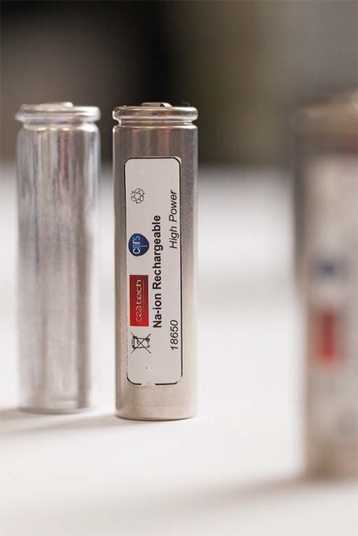Sodium-ion battery in 18650 format

Researchers have designed an alternative technology to Li-ion for application in specific sectors. The new battery prototype uses sodium ions in the usual ‘18650’ format, an industry standard.
The main advantage of the prototype, developed by CNRS and CEA researchers in France, is that it relies on sodium, an element far more abundant and less costly than lithium. The batteries have displayed performance levels comparable to their lithium counterparts, and this new technology is already attracting industrial interest. It could be used to store renewable energies in the future.
The idea for using sodium in batteries dates back to the 1980s. At the time, lithium was preferred to sodium as the material of choice and it has been widely used ever since for portable electronic devices such as tablets, laptops and electric vehicles. However, lithium has a major drawback in that it is fairly rare on our planet. Teams from the French network RS2E (with the CNRS as the leading partner) therefore turned towards sodium, a thousand times more abundant. They developed sodium-ion battery prototypes where sodium ions move from one electrode to another in a liquid during the charge and discharge cycles.
The first step was to find the ideal ‘recipe’ for the positive electrode (cathode) of the battery. Six partner laboratories of the RS2E (see list below) were involved in the project with the goal to find the right composition for this sodium electrode. The development of a future prototype was then entrusted to CEA, a member of the RS2E network. In only six months, CEA was able to develop the first sodium-ion prototype in the ‘18650’ format, that of the batteries found on the market, ie, a cylinder 1.8 cm in diameter and 6.5 cm in height. This should facilitate technology transfer to existing production units.
This second stage made it possible to move from the laboratory scale (synthesis of several grams of cathode material) to the ‘pre-industrial’ scale (synthesis of 1 kg batches). It enabled the production of batteries with unmatched power performance levels.
This new technology is already showing promising results. Its energy density (the quantity of electricity that can be stored by kg of battery) amounts to 90 Wh/kg, a figure already comparable with the first lithium-ion batteries. And its lifespan — the maximum number of charge/discharge cycles that a battery can withstand without any significant loss of performance — exceeds 2000 cycles. But most of all, these cells are capable of charging and delivering their energy very rapidly. The main advantage of the technology is that it does away with lithium, a rare element only found in specific locations, contrary to sodium. Its other advantage is financial, as using sodium could make it possible to manufacture less expensive batteries.
Bearing in mind the similarities with lithium-ion batteries, industrial players have already expressed interest in the technology, notably those who already work in partnership with the RS2E network.
The next stage of the project is to optimise and increase the reliability of processes with a view to future commercialisation.
Boosting performance of aqueous zinc–iodine batteries
Engineers from the University of Adelaide have enhanced aqueous zinc–iodine batteries using...
Sodium-ion battery breakthrough boosts energy storage
Scientists have discovered that leaving water inside a key material, rather than removing it,...
Setting a new standard for solar efficiency testing
Researchers from Simon Fraser University have proposed a new framework to standardise testing of...





